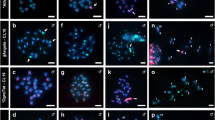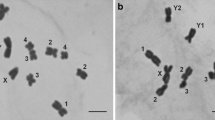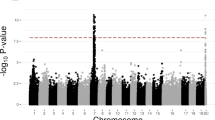Abstract
Rumex papillaris Boiss, & Reut., an Iberian endemic, belongs to the section Acetosa of the genus Rumex whose main representative is R. acetosa L., a species intensively studied in relation to sex-chromosome evolution. Here, we characterize cytogenetically the chromosomal complement of R. papillaris in an effort to enhance future comparative genomic approaches and to better our understanding of sex chromosome structure in plants. Rumex papillaris, as is common in this group, is a dioecious species characterized by the presence of a multiple sex chromosome system (with females 2n = 12 + XX and males 2n = 12 + XY1Y2). Except for the X chromosome both Y chromosomes are the longest in the karyotype and appear heterochromatic due to the accumulation of at least two satellite DNA families, RAE180 and RAYSI. Each chromosome of pair VI has an additional major heterochromatin block at the distal region of the short arm. These supernumerary heterochromatic blocks are occupied by RAE730 satellite DNA family. The Y-related RAE180 family is also present in an additional minor autosomal locus. Our comparative study of the chromosomal organization of the different satellite-DNA sequences in XX/XY and XX/XY1Y2Rumex species demonstrates that of active mechanisms of heterochromatin amplification occurred and were accompanied by chromosomal rearrangements giving rise to the multiple XX/XY1Y2 chromosome systems observed in Rumex. Additionally, Y1 and Y2 chromosomes have undergone further rearrangements leading to differential patterns of Y-heterochromatin distribution between Rumex species with multiple sex chromosome systems.





Similar content being viewed by others
Abbreviations
- A:
-
Adenosine
- bp:
-
Base pair(s)
- DAPI:
-
4′,6-diamidino-2-phenylindole
- dNTP:
-
Deoxyribonucleoside triphosphate
- EDTA:
-
Ethylenediaminetetraacetic acid
- h:
-
Hour(s)
- ng:
-
Nanogram(s)
- ml:
-
Milliliter(s)
- mya:
-
Million years ago
- PCR:
-
Polymerase chain reaction
- SDS:
-
Sodium dodecyl sulfate
- SSC:
-
Saline–sodium citrate
- T:
-
Thymidine
References
Ainsworth CC, Lu J, Winfield M et al (1999) Sex determination by X: autosome dosage: Rumex acetosa (sorrel). In: Ainsworth CC (ed) Sex determination in plants. BIOS Scientific Publishers Limited, pp 124–136
Charlesworth B (1996) The evolution of chromosomal sex determination and dosage compensation. Curr Biol 6:149–162
Cuñado N, Navajas-Pérez R, de la Herrán R et al (2007) The evolution of sex chromosomes in the genus Rumex (Polygonaceae): identification of a new species with heteromorphic sex chromosomes. Chromosome Res 15:825–833
Degraeve N (1976) Contribution à l’étude cytotaxonomique des Rumex. IV Le genre Acetosa Mill. Cellule 71:231–240
Kihara H, Ono T (1923) Cytological studies on Rumex L. I. Chromosomes of Rumex acetosa L. Bot Mag Tokyo 37:84–90
Koch M, Haubold AB, Mitchell-Olds T (2000) Comparative evolutionary analysis of chalcone synthase and alcohol dehydrogenase loci in Arabidopsis, Arabis, and related genera (Brassicaceae). Mol Biol Evol 17:1483–1498
Kuroki Y (1987) Karyotype variation and heterochromatin in Rumex acetosa. Plant Chromosome Res 1987. Nishiki Print Co, Ltd, Hiroshima, Japan, pp 227–230
Kuroki Y, Yokohama A, Iwatsubo Y (1994) Fluorescent chromosome banding in Rumex montanus (Polygonaceae). Kromosomo 74:2591–2597
Lengerova M, Vyskot B (2001) Sex chromatin and nucleolar analyses in Rumex acetosa L. Protoplasma 217:147–153
López González G (1990) Género Rumex L. In: Castroviejo S, Laínz M, López González G, Montserrat P, Muñoz Garmendia F, Paiva J, Villar L (eds) Flora Iberica, vol 2. CSIC, Real Jardín Botánico de Madrid, Madrid, Spain, pp 595–634
Löve Á (1944) Cytogenetic studies on Rumex subgenus acetosella. Hereditas 30:1–136
Löve Á, Kapoor B (1967) A chromosome atlas of the collective genus Rumex. Cytologia 32:320–342
Mariotti B, Navajas-Pérez R, Lozano R et al (2006) Cloning and characterisation of dispersed repetitive DNA derived from microdissected sex chromosomes of Rumex acetosa. Genome 49:114–121
Mosiolek M, Pasierbek P, Malarz J et al (2005) Rumex acetosa Y chromosomes: constitutive or facultative heterochromatin? Folia Histochem Cytobiol 43:161–167
Navajas-Pérez R, de la Herrán R, López González G et al (2005a) The evolution of reproductive systems and sex-determining mechanisms within Rumex (Polygonaceae) inferred from nuclear and chloroplastidial sequence data. Mol Biol Evol 22:1929–1939
Navajas-Pérez R, de la Herrán R, Jamilena M et al (2005b) Reduced rates of sequence evolution of Y-linked satellite DNA in Rumex (Polygonaceae). J Mol Evol 60:391–399
Navajas-Pérez R, Schwarzacher T, de la Herrán R et al (2006) The origin and evolution of the variability in a Y-specific satellite-DNA of Rumex acetosa and its relatives. Gene 368:61–71
Nicolas M, Marais G, Hykelova V et al (2005) A gradual process of recombination restriction in the evolutionary history of the sex chromosomes in dioecious plants. PLoS Biol 3:47–56
Rechinger KH Jr (1964) The genus Rumex L. In: Tutin TG, Heywood VH, Burges NA, Valentine DH, Walters SM, Webb DA (eds) Flora Europaea, vol 1. Cambridge University Press, Cambridge, UK, pp 82–89
Renner SS, Ricklefs RE (1995) Dioecy and its correlates in the flowering plants. Am J Bot 82:596–606
Ruiz Rejón M (2004) Sex chromosomes in plants. In: Goodman RM (ed) Encyclopedia of plant and crop sciences, vol 4. Dekker Agropedia, Marcel Dekker, New York, pp 1148–1151
Ruiz Rejón C, Jamilena M, Garrido-Ramos MA et al (1994) Cytogenetic and molecular analysis of the multiple sex chromosome system of Rumex acetosa. Heredity 72:209–215
Schwarzacher T (2003) DNA, chromosomes and in situ hybridization. Genome 46:953–962
Schwarzacher T, Heslop-Harrison JS (2000) Practical in situ hybridization. BIOS Scientific Publishers Limited, Oxford, UK
Shibata F, Hizume M, Kuroki Y (1999) Chromosome painting of Y chromosomes and isolation of a Y chromosome-specific repetitive sequence in the dioecious plant Rumex acetosa. Chromosoma 108:266–270
Shibata F, Hizume M, Kuroki Y (2000a) Differentiation and the polymorphic nature of the Y chromosomes revealed by repetitive sequences in the dioecious plant, Rumex acetosa. Chromosome Res 8:229–236
Shibata F, Hizume M, Kuroki Y (2000b) Molecular cytogenetic analysis of supernumerary heterochromatic segments in Rumex acetosa. Genome 43:391–397
Smith BW (1964) The evolving karyotype of Rumex hastatulus. Evolution 18:93–104
Smith BW (1968) Cytogeography and cytotaxonomic relationships of Rumex paucifolius. Am J Bot 55:673–683
Skaletsky H, Kuroda-Kawaguchi T, Minx PJ et al (2003) The male-specific region of the human Y chromosome is a mosaic of discrete sequence classes. Nature 423:825–837
Steinemann M, Steinemann S (1997) The enigma of the Y chromosome degeneration: TRAM, a novel retrotransposon is preferentially located on the neo-Y chromosome of Drosophila miranda. Genetics 145:261–266
Wilby AS, Parker JS (1988a) The supernumerary segment systems of Rumex acetosa. Heredity 60:109–117
Wilby AS, Parker JS (1988b) Recurrent patterns of chromosome variation in a species group. Heredity 61:55–62
Yu Q, Hou S, Feltus FA et al (2008a) Low X/Y divergence in four pairs of papaya sex-linked genes. Plant J 53:124–132
Yu Q, Navajas-Pérez R, Tong E et al (2008b) Recent origin of dioecious and gynodioecious Y chromosomes in papaya. Trop Plant Biol. doi: 10.1007/s12042-007-9005-7
Acknowledgements
We thank Dr John Bailey, University of Leicester, for helpful discussions and checking the English of the manuscript. This work was supported by grant CGL2006-00444/BOS awarded by the Ministerio de Educación y Ciencia, Spain. We are deeply indebted to the Parque Natural de la Sierra de Baza in Granada (Spain), for kindly providing the material analyzed in this paper. R.N.P. is a Fulbright postdoctoral scholar supported by grant FU-2006-0675 of Spanish M.E.C.
Author information
Authors and Affiliations
Corresponding author
Rights and permissions
About this article
Cite this article
Navajas-Pérez, R., Schwarzacher, T., Rejón, M.R. et al. Molecular cytogenetic characterization of Rumex papillaris, a dioecious plant with an XX/XY1Y2 sex chromosome system. Genetica 135, 87–93 (2009). https://doi.org/10.1007/s10709-008-9261-y
Received:
Accepted:
Published:
Issue Date:
DOI: https://doi.org/10.1007/s10709-008-9261-y




